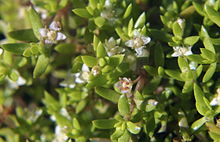Crassula helmsii
| Swamp stonecrop | |
|---|---|

| |
| Leaves and flowers of C. helmsii | |
| Scientific classification | |
| Kingdom: | Plantae |
| Clade: | Tracheophytes |
| Clade: | Angiosperms |
| Clade: | Eudicots |
| Order: | Saxifragales |
| Family: | Crassulaceae |
| Genus: | Crassula |
| Species: | C. helmsii |
| Binomial name | |
| Crassula helmsii | |
| Synonyms | |
| |
Crassula helmsii, known as swamp stonecrop or New Zealand pigmyweed,[1] is an aquatic or semiterrestrial species of succulent plant in the family Crassulaceae.[2] Originally found in Australia and New Zealand, it has been introduced around the world. In the United Kingdom, this plant is one of five introduced invasive aquatic plants that were banned from sale from April 2014, the first ban of its kind in the country.[3] It is on the Global Biodiversity Information Facility's Global Register of Introduced and Invasive Species of eleven countries.[4]
Description
The shoots are rather stiff, carrying narrow parallel-sided leaves in opposite pairs, each leaf being about 4–24 millimetres (0.16–0.94 in). Small white flowers with four petals are produced in summer on long stalks arising from the upper leaf axils. The flowers are always above water.[citation needed]
Distribution
On the island of Ireland, C. helmsii has recently been recorded on waste ground in Ireland at Howth Head, County Dublin,[5] and at a number of sites in Northern Ireland.[6]
Ecological aspects
The plant grows on the muddy margins of ponds where it forms carpets with 100% cover, semi-submerged in deeper water, or totally submerged with elongated stems. It does not die back in winter.[6] It has been reported to be very tolerant to copper toxicity[7] and to be a hyperaccumulator of copper.[8]
Cultivation
C. helmsii is able to grow fully submerged in a cool-water aquarium or as a submersed or marginal plant in a pond. Once established it can grow vigorously and may need to be trimmed back. Schedule 9 of the UK Wildlife and Countryside Act 1981 lists this plant as one that must not be caused to grow in the wild.[9]
References
- ^ BSBI List 2007 (xls). Botanical Society of Britain and Ireland. Archived from the original (xls) on 2015-06-26. Retrieved 2014-10-17.
- ^ "Crassula helmsii (aquatic plant, succulent)". Global Invasive Species Database. ISSG. April 15, 2010. Archived from the original on May 9, 2012. Retrieved March 8, 2012.
- ^ "UK bans sale of five invasive non-native aquatic plants". BBC News. 29 January 2013.
- ^ "Crassula helmsii A.Berger". www.gbif.org. Retrieved 2020-04-04.
- ^ Ni Dhuill, E. (2021). "Invasive non-native and alien garden escape plant species on the southern cliffs of Howth Head, Co. Dublin (H21)". Irish Naturalists' Journal. 37 (2): 102–108.
- ^ a b Hackney, Paul (n.d.). "Crassula helmsii, New Zealand Pigmyweed". Invasive Alien Species in Northern Ireland. National Museums Northern Ireland. Archived from the original on 20 April 2019. Retrieved 17 April 2022.
- ^ Küpper, Hendrik; Küpper, Frithjof; Spiller, Martin (1996). "Environmental relevance of heavy metal-substituted chlorophylls using the example of water plants". Journal of Experimental Botany. 47 (2): 259–266. doi:10.1093/jxb/47.2.259. ISSN 0022-0957.
- ^ Küpper, Hendrik; Götz, Birgit; Mijovilovich, Ana; Küpper, Frithjof C.; Meyer-Klaucke, Wolfram (2009-10-01). "Complexation and Toxicity of Copper in Higher Plants. I. Characterization of Copper Accumulation, Speciation, and Toxicity in Crassula helmsii as a New Copper Accumulator". Plant Physiology. 151 (2): 702–714. doi:10.1104/pp.109.139717. ISSN 0032-0889. PMC 2754650. PMID 19641032.
- ^ Statutory Instrument 2010 No. 609 (section 2) The Wildlife and Countryside Act 1981 (Variation of Schedule 9) (England and Wales) Order 2010 (Coming into force 6 April 2010)
External links
- Crassula helmsii GBIF (images, distribution, invasive species status)
- BioImages
- Status in N. Ireland Archived 2019-04-20 at the Wayback Machine includes an introduction on UK information
- Flora of N. Ireland - illustrated
- Ecological information
